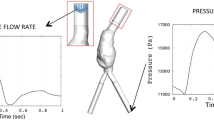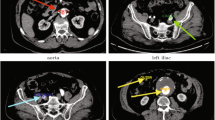Abstract
Abdominal aortic aneurysm wall distensibility can be estimated by measuring pulse pressure and the corresponding sac volume change, which can be obtained by measuring wall displacement. This approach, however, may introduce error if the role of thrombus in assisting the wall in bearing the pulse pressure loading is neglected. Our aim was to introduce a methodology for evaluating and potentially correcting this error in estimating distensibility. Electrocardiogram-gated computed tomography images of eleven patients were obtained, and the volume change between diastole and systole was measured. Using finite element procedures, we determined the equivalent pulse pressure loading that should be applied to the wall of a model where thrombus was digitally removed, to yield the same sac volumetric increase caused by applying the luminal pulse pressure to the model with thrombus. The equivalent instead of the measured pulse pressure was used in the distensibility expression. For a relative volumetric thrombus deposition (V ILT) of 50 %, a 62 % distensibility underestimation resulted when thrombus role was neglected. A strong linear correlation was observed between distensibility underestimation and V ILT. To assess the potential value of noninvasive wall distensibility measurement in rupture risk stratification, the role of thrombus on wall loading should be further investigated.




Similar content being viewed by others
References
Adolph R, Vorp DA, Steed DL, Webster MW, Kameneva MV, Watkins SC (1997) Cellular content and permeability of intraluminal thrombus in abdominal aortic aneurysm. J Vasc Surg 25:916–926
Antiga L, Piccinelli M, Botti L, Ene-Iordache B, Remuzzi A, Steinman DA (2008) An image-based modeling framework for patient-specific computational hemodynamics. Med Biol Eng Comput 46:1097–1112
Ashton JH, Vande Geest JP, Simon BR, Haskett DG (2009) Compressive mechanical properties of the intraluminal thrombus in abdominal aortic aneurysms and fibrin-based thrombus mimics. J Biomech 42:197–201
Boschetti F, Di Martino EM, Giota G (2007) A poroviscoelastic model of intraluminal thrombus from abdominal aortic aneurysms. In: 2007 Summer bioengineering conference, Keystone CO
Breeuwer M, de Putter S, Kose U, Speelman L, Visser K, Gerritsen F, Hoogeveen R, Krams R, van den Bosch H, Buth J, Gunther T, Wolters B, van Dam E, van de Vosse F (2008) Towards patient-specific risk assessment of abdominal aortic aneurysm. Med Biol Eng Comput 46:1085–1095
Collet JP, Shuman H, Ledger RE, Lee S, Weisel JW (2005) The elasticity of an individual fibrin fiber in a clot. Proc Natl Acad Sci U S A 102:9133–9137
Di Martino E, Mantero S, Inzoli F, Melissano G, Astore D, Chiesa R, Fumero R (1998) Biomechanics of abdominal aortic aneurysm in the presence of endoluminal thrombus: experimental characterisation and structural static computational analysis. Eur J Vasc Endovasc Surg 15:290–299
Di Martino ES, Bohra A, Van de Geest JP, Gupta N, Makaroun MS, Vorp DA (2006) Biomechanical properties of ruptured versus electively repaired abdominal aortic aneurysm wall tissue. J Vasc Surg 43:570–576 (discussion 576)
Doyle BJ, Callanan A, McGloughlin TM (2007) A comparison of modelling techniques for computing wall stress in abdominal aortic aneurysms. Biomed Eng Online 6:38
Gasser TC, Gorgulu G, Folkesson M, Swedenborg J (2008) Failure properties of intraluminal thrombus in abdominal aortic aneurysm under static and pulsating mechanical loads. J Vasc Surg 48:179–188
Gasser TC, Martufi G, Auer M, Folkesson M, Swedenborg J (2010) Micromechanical characterization of intra-luminal thrombus tissue from abdominal aortic aneurysms. Ann Biomed Eng 38:371–379
Govindjee S, Mihalic P (1998) Computational methods for inverse deformations in quasi-incompressible finite elasticity. Int J Numer Meth Eng 43:821–838
He CM, Roach MR (1994) The composition and mechanical properties of abdominal aortic aneurysms. J Vasc Surg 20:6–13
Helderman F, Manoch IJ, Breeuwer M, Kose U, Schouten O, van Sambeek MR, Poldermans D, Pattynama PT, Wisselink W, van der Steen AF, Krams R (2008) A numerical model to predict abdominal aortic aneurysm expansion based on local wall stress and stiffness. Med Biol Eng Comput 46:1121–1127
Hellenthal FA, Geenen IL, Teijink JA, Heeneman S, Schurink GW (2009) Histological features of human abdominal aortic aneurysm are not related to clinical characteristics. Cardiovasc Pathol 18:286–293
Hinnen JW, Koning OH, Visser MJ, Van Bockel HJ (2005) Effect of intraluminal thrombus on pressure transmission in the abdominal aortic aneurysm. J Vasc Surg 42:1176–1182
Kirk B, Peterson J, Stogner R, Carey G (2006) libMesh: a C++ library for parallel adaptive mesh refinement/coarsening simulations. Eng with Comput 22:237–254
Kontopodis N, Metaxa E, Pagonidis K, Ioannou C, Papaharilaou Y (2013) Deformation and distensibility distribution along the abdominal aorta in the presence of aneurysmal dilatation. J Cardiovasc Surg (Torino) (in press)
Li ZY, Tang TY, Soh E, See TC, Gillard JH (2008) Impact of calcification and intraluminal thrombus on the computed wall stresses of abdominal aortic aneurysm. J Vasc Surg 47:928–935
MacSweeney ST (1999) Mechanical properties of abdominal aortic aneurysm and prediction of risk of rupture. Cardiovasc Surg 7:158–159
Merkx MA, van’t Veer M, Speelman L, Breeuwer M, Buth J, van de Vosse FN (2009) Importance of initial stress for abdominal aortic aneurysm wall motion: dynamic MRI validated finite element analysis. J Biomech 42:2369–2373
Meyer CA, Guivier-Curien C, Moore JE Jr (2010) Trans-thrombus blood pressure effects in abdominal aortic aneurysms. J Biomech Eng 132:071005
Molacek J, Baxa J, Houdek K, Treska V, Ferda J (2011) Assessment of abdominal aortic aneurysm wall distensibility with electrocardiography-gated computed tomography. Ann Vasc Surg 25:1036–1042
Molony DS, Callanan A, Kavanagh EG, Walsh MT, McGloughlin TM (2009) Fluid-structure interaction of a patient-specific abdominal aortic aneurysm treated with an endovascular stent-graft. Biomed Eng Online 8:24
Mower WR, Quinones WJ, Gambhir SS (1997) Effect of intraluminal thrombus on abdominal aortic aneurysm wall stress. J Vasc Surg 26:602–608
Polzer S, Gasser TC, Markert B, Bursa J, Skacel P (2012) Impact of poroelasticity of intraluminal thrombus on wall stress of abdominal aortic aneurysms. Biomed Eng Online 11:62
Raghavan ML, Vorp DA (2000) Toward a biomechanical tool to evaluate rupture potential of abdominal aortic aneurysm: identification of a finite strain constitutive model and evaluation of its applicability. J Biomech 33:475–482
Raut SS, Jana A, De Oliveira V, Muluk SC, Finol EA (2013) The importance of patient-specific regionally varying wall thickness in abdominal aortic aneurysm biomechanics. J Biomech Eng 135:81010
Schurink GW, van Baalen JM, Visser MJ, van Bockel JH (2000) Thrombus within an aortic aneurysm does not reduce pressure on the aneurysmal wall. J Vasc Surg 31:501–506
Sonesson B, Hansen F, Lanne T (1997) Abdominal aortic aneurysm: a general defect in the vasculature with focal manifestations in the abdominal aorta? J Vasc Surg 26:247–254
Speelman L, Schurink GW, Bosboom EM, Buth J, Breeuwer M, van de Vosse FN, Jacobs MH (2010) The mechanical role of thrombus on the growth rate of an abdominal aortic aneurysm. J Vasc Surg 51:19–26
Taubin G (1995) Curve and surface smoothing without shrinkage. In: IEEE Computer Society proceedings of the fifth international conference on computer vision (ICCV ‘95), p 852
Thubrikar MJ, Robicsek F, Labrosse M, Chervenkoff V, Fowler BL (2003) Effect of thrombus on abdominal aortic aneurysm wall dilation and stress. J Cardiovasc Surg (Torino) 44:67–77
van’t Veer M, Buth J, Merkx M, Tonino P, van den Bosch H, Pijls N, van de Vosse F (2008) Biomechanical properties of abdominal aortic aneurysms assessed by simultaneously measured pressure and volume changes in humans. J Vasc Surg 48:1401–1407
van Dam EA, Dams SD, Peters GW, Rutten MC, Schurink GW, Buth J, van de Vosse FN (2008) Non-linear viscoelastic behavior of abdominal aortic aneurysm thrombus. Biomech Model Mechanobiol 7:127–137
Vavourakis V, Papaharilaou Y, Ekaterinaris JA (2011) Coupled fluid–structure interaction hemodynamics in a zero-pressure state corrected arterial geometry. J Biomech 44:2453–2460
Wang DH, Makaroun M, Webster MW, Vorp DA (2001) Mechanical properties and microstructure of intraluminal thrombus from abdominal aortic aneurysm. J Biomech Eng 123:536–539
Wang DH, Makaroun MS, Webster MW, Vorp DA (2002) Effect of intraluminal thrombus on wall stress in patient-specific models of abdominal aortic aneurysm. J Vasc Surg 36:598–604
Wilson JS, Virag L, Di Achille P, Karsaj I, Humphrey JD (2013) Biochemomechanics of intraluminal thrombus in abdominal aortic aneurysms. J Biomech Eng 135:021011
Wilson KA, Lee AJ, Lee AJ, Hoskins PR, Fowkes FG, Ruckley CV, Bradbury AW (2003) The relationship between aortic wall distensibility and rupture of infrarenal abdominal aortic aneurysm. J Vasc Surg 37:112–117
Xenos M, Alemu Y, Zamfir D, Einav S, Ricotta JJ, Labropoulos N, Tassiopoulos A, Bluestein D (2010) The effect of angulation in abdominal aortic aneurysms: fluid–structure interaction simulations of idealized geometries. Med Biol Eng Comput 48:1175–1190
Yushkevich PA, Piven J, Hazlett HC, Smith RG, Ho S, Gee JC, Gerig G (2006) User-guided 3d active contour segmentation of anatomical structures: significantly improved efficiency and reliability. Neuroimage 31:1116–1128
Acknowledgments
The research project is financially supported by the Action “Supporting Postdoctoral Researchers”, co-financed by the European Social Fund (ESF) and the Greek State.
Author information
Authors and Affiliations
Corresponding author
Rights and permissions
About this article
Cite this article
Metaxa, E., Kontopodis, N., Vavourakis, V. et al. The influence of intraluminal thrombus on noninvasive abdominal aortic aneurysm wall distensibility measurement. Med Biol Eng Comput 53, 299–308 (2015). https://doi.org/10.1007/s11517-014-1235-x
Received:
Accepted:
Published:
Issue Date:
DOI: https://doi.org/10.1007/s11517-014-1235-x




